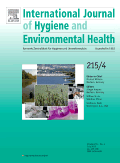
INTERNATIONAL JOURNAL OF HYGIENE AND ENVIRONMENTAL HEALTH
Scope & Guideline
Pioneering excellence in hygiene and environmental health research.
Introduction
Aims and Scopes
- Environmental Exposure Assessment:
The journal publishes research assessing various environmental exposures, such as air pollution, chemical contaminants, and pathogens, and their associations with health outcomes. - Public Health Interventions:
It emphasizes studies that evaluate the effectiveness of public health interventions aimed at improving hygiene practices, sanitation, and overall health in different populations. - Biomonitoring Studies:
A significant portion of the research involves biomonitoring to assess human exposure to pollutants, chemicals, and pathogens, providing crucial data for policy and health guidelines. - Epidemiological Research:
The journal features epidemiological studies that explore the relationships between environmental factors and health outcomes, contributing valuable insights into disease prevention. - Climate Change and Health:
Research related to the health impacts of climate change, including extreme weather events and their implications for water and sanitation, is a key focus area.
Trending and Emerging
- Chemical Exposure and Health Outcomes:
There is a growing emphasis on the health impacts of exposure to chemicals such as phthalates, PFAS, and flame retardants, reflecting increased public awareness and regulatory scrutiny. - Mental Health and Environmental Factors:
Emerging research links environmental factors, including air pollution and green spaces, to mental health outcomes, highlighting the importance of environmental psychology in public health. - Impact of Climate Change on Health:
Studies exploring the health implications of climate change, including heatwaves and air quality degradation, are increasingly featured, indicating a shift in research priorities. - Infectious Disease Surveillance through Environmental Monitoring:
The journal is expanding its focus on using environmental monitoring, such as wastewater analysis, to track infectious diseases like SARS-CoV-2, emphasizing the need for innovative surveillance methods. - Community-Level Interventions and Health Equity:
Research addressing health equity through community-level sanitation and hygiene interventions is gaining traction, highlighting the importance of social determinants of health.
Declining or Waning
- Occupational Health in Traditional Industries:
Research on traditional industries, such as agriculture and manufacturing, has decreased, possibly due to a shift towards more pressing contemporary issues such as climate change and urban health. - Historical Environmental Health Studies:
There is a declining focus on historical studies that assess past exposures, as the journal seeks to prioritize current and future challenges in environmental health. - Localized Sanitation Issues:
Studies focusing solely on localized sanitation issues without broader implications or connections to global health trends have become less frequent. - Single Exposures without Contextual Analysis:
Research examining single environmental exposures without considering the broader context of multiple exposures and their cumulative effects is waning as interdisciplinary approaches gain traction. - Conventional Water Quality Studies:
Traditional studies on water quality without innovative methodologies or integration with human health outcomes are becoming less common as the field evolves.
Similar Journals
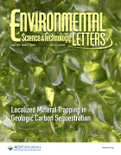
Environmental Science & Technology Letters
Exploring critical insights for a cleaner planet.Environmental Science & Technology Letters, published by the American Chemical Society, stands as a premier journal in the realm of environmental science and technology, focusing on pivotal studies that address pressing environmental challenges. With an impressive Q1 ranking in multiple categories including Ecology, Environmental Chemistry, and Pollution, this journal maintains a position of excellence within its field, achieving Scopus ranks that place it in the top percentile of Environmental Science disciplines. Although not open access, Environmental Science & Technology Letters offers vital insights and cutting-edge research that contribute significantly to the understanding and management of environmental issues. The journal’s objectives include disseminating ground-breaking findings and promoting discussions that lead to sustainable solutions. With convergence from 2013 to 2024, it continues to serve as an essential resource for researchers, professionals, and students committed to advancing knowledge and innovation in environmental science.
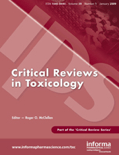
CRITICAL REVIEWS IN TOXICOLOGY
Pioneering Comprehensive Reviews in Toxicological SciencesCRITICAL REVIEWS IN TOXICOLOGY, published by Taylor & Francis Ltd, stands as a preeminent journal within the field of toxicology, boasting an impressive Q1 ranking and holding the distinction of being ranked 12th out of 133 in the toxicology category according to Scopus, placing it in the top 91st percentile. With a continuous publication history since 1971 and a commitment to providing high-quality reviews, the journal offers critical insight into the latest research and advancements in toxicological sciences. While it is not an open-access journal, it provides numerous access options for both subscribers and institutions, ensuring that its extensive articles are widely available to the academic community. The journal's objectives are to disseminate comprehensive reviews that foster understanding and innovation in the assessment of chemical risks, environmental impacts, and the mechanisms of toxicity, making it an invaluable resource for researchers, professionals, and students dedicated to the science of toxicology.
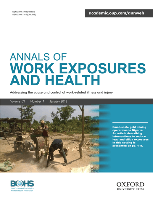
Annals of Work Exposures and Health
Bridging research and practice in health exposures.Annals of Work Exposures and Health, published by Oxford University Press, stands as a leading journal dedicated to the field of public health with a particular focus on environmental and occupational health issues. Since its inception in 2016, the journal has provided a robust platform for disseminating high-quality research, boasting an impressive impact factor that reflects its rigorous peer-review process and significant contribution to advancing knowledge in the field. With its open access model, the journal ensures that critical findings are readily available to researchers, professionals, and students, fostering a collaborative spirit in tackling the challenges associated with work-related health exposures. As of 2023, it ranks in Q2 in its category, positioned within the 69th percentile in Scopus, illustrating its influence and relevance in the ongoing discourse surrounding occupational health. The Annals continues to attract diverse contributions that aim to inform policy and practice, making it an essential resource for anyone involved in public health research and advocacy.

ENVIRONMENTAL HEALTH PERSPECTIVES
Transforming research into action for public health.Environmental Health Perspectives (EHP) is a premier open-access journal published by the U.S. Department of Health and Human Services, Public Health Science, dedicated to publishing rigorous and impactful research in the field of environmental health. Since its inception in 1972, EHP has become a leading platform for disseminating knowledge on the interactions between the environment and human health, making significant contributions to the fields of toxicology and public health. With an impressive impact factor and a Q1 ranking in both Health, Toxicology and Mutagenesis and Public Health, Environmental and Occupational Health categories, EHP ranks among the top journals globally, reflecting its high citation and visibility within the academic community. Researchers, professionals, and students alike will find a wealth of vital information within its pages, as EHP covers a wide array of topics related to environmental exposures, health outcomes, and policy implications. Furthermore, EHP engages with a global audience through its commitment to open access, ensuring that critical research is available to all, enhancing the collective understanding of environmental health issues since 1972.

Environmental Health
Empowering Research for a Sustainable FutureEnvironmental Health is a premier, peer-reviewed journal dedicated to advancing knowledge in the interdisciplinary field of environmental health. Published by BMC since 2002, this Open Access journal aims to disseminate impactful research that addresses the critical intersections between environmental factors and public health. With its impressive stature as a Q1 journal in key categories, including Health, Toxicology and Mutagenesis, Medicine (miscellaneous), and Public Health, Environmental and Occupational Health, it ranks within the top tier of its field, boasting significant visibility and a high impact factor as demonstrated by Scopus rankings. Scholars and practitioners alike benefit from its well-rounded approach and commitment to bridging science and policy, making it essential reading for anyone invested in understanding and mitigating environmental health risks. The journal is based in the United Kingdom, with a focus on promoting global accessibility to its findings.

Environnement Risques & Sante
Empowering Research for a Healthier PlanetEnvironnement Risques & Sante is a prominent journal focused on the intersection of environmental issues, public health, and safety, offering a platform for scholarly discourse on the critical challenges posed by environmental risks to human health. Published by JOHN LIBBEY EUROTEXT LTD, this journal aims to disseminate impactful research that enhances our understanding of toxicology, mutagenesis, and their implications for public health policy and practices. Though it ceased coverage in Scopus in 2021, its historical contributions remain relevant, addressing urgent topics in environmental science and occupational health. Researchers and professionals engaged in these fields will find valuable insights and findings that inform practice and promote sustainable solutions. For interested readers, further exploration of the journal can provide essential knowledge in coping with contemporary environmental health challenges.

GEFAHRSTOFFE REINHALTUNG DER LUFT
Connecting science and policy for a sustainable atmosphere.GEFAHRSTOFFE REINHALTUNG DER LUFT is a reputable academic journal published by SPRINGER-V D I VERLAG GMBH & CO KG, dedicated to the critical examination of air contamination and its implications on public health and environmental policy. With an ISSN of 0949-8036 and an E-ISSN of 1436-4891, this journal has established itself as a key resource for researchers, professionals, and students alike since its inception in 1996. Operating under a stringent peer-review process, it focuses on various aspects of air quality management, toxicology, and the legal frameworks governing pollution control. Although categorized in the Q4 quartile for multiple areas including Health, Toxicology and Mutagenesis and Management, Monitoring, Policy and Law, the journal continues to play an important role in disseminating relevant research that aids in the understanding and mitigation of air pollution issues. As of 2023, it ranks in the 7th percentile across several environmental science categories, reflecting its niche but impactful presence in the field. Researchers looking to stay ahead in the study of air quality are encouraged to explore this journal, which is set to converge its insights through 2024 and beyond.

Lancet Planetary Health
Empowering voices in the fight for environmental health.Lancet Planetary Health is a distinguished, open-access journal published by Elsevier Science Ltd, focusing on critical intersections between global health and environmental sustainability. Launched in 2017 and located in the Netherlands, this journal has quickly established itself as a leading platform for innovative research, evidenced by its Q1 ranking across multiple categories in 2023 including Health Policy, Public Health, and Environmental and Occupational Health. With an impressive Scopus ranking, placing it in the top 1% of similar journals, Lancet Planetary Health aims to foster interdisciplinary conversation and collaboration among researchers, policymakers, and practitioners dedicated to addressing the health challenges posed by climate change and environmental degradation. The open access model not only enhances the visibility of published research but also promotes widespread dissemination of knowledge, making it an essential resource for anyone committed to advancing the field of planetary health.
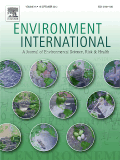
ENVIRONMENT INTERNATIONAL
Uncovering the Science Behind Sustainable DevelopmentENVIRONMENT INTERNATIONAL is a premier journal dedicated to advancing the field of environmental science. Published by PERGAMON-ELSEVIER SCIENCE LTD, it boasts an impressive impact factor and holds a prestigious Q1 classification in the Environmental Science category, reflecting its influence and reputation within academia. Since transitioning to Open Access in 2019, the journal has increased its accessibility, allowing a wider audience—from researchers to industry professionals—to engage with cutting-edge studies that address crucial environmental challenges. With a Scopus rank of #3 out of 233 in General Environmental Science and a commendable 98th percentile, ENVIRONMENT INTERNATIONAL is committed to publishing high-quality research that informs policy and practice. Covering a broad spectrum of topics from pollution and climate change to sustainable development, this journal serves as a vital resource for those dedicated to making a positive impact on our planet. For submissions, inquiries, or to explore its extensive archives dating from 1976 to 2024, please visit their site at the Kidlington, Oxford headquarters.

Environmental Health and Preventive Medicine
Innovating preventive strategies for a sustainable future.Environmental Health and Preventive Medicine is a leading, peer-reviewed journal published by the Japanese Society for Hygiene, dedicated to advancing the field of environmental health and preventive medicine. With an impressive Impact Factor and ranking within the top quintile (Q1) in both Medicine (miscellaneous) and Public Health, Environmental and Occupational Health categories, this journal is recognized for its high-quality research and significant contributions to public health discussions globally. Established in 1996 and transitioning to an Open Access model since 2008, it provides unrestricted access to important findings that serve a diverse audience, including researchers, practitioners, and students. The journal's scope encompasses a wide range of topics essential for understanding environmental health issues and formulating effective preventive strategies, making it an invaluable resource for anyone engaged in health policy, environmental science, or community health initiatives. With an active readership and impactful research, Environmental Health and Preventive Medicine continues to influence the future direction of public health and environmental policies.